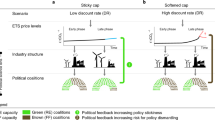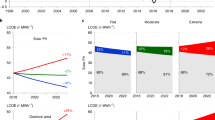Abstract
Governments procure renewables through a variety of mechanisms. Contracts for difference (CfDs) have been used for more than 50% of the global offshore wind supply. The payments awarded through CfDs are sometimes labelled subsidies, suggesting that they support uneconomic activity. Here, we argue that the primary role of CfDs is rather risk management by creating a market for electricity supply at stable long-term prices. Similar to its use in other sectors of the economy, this contract type transforms a variable to a fixed price to reallocate volatility risks. Such long-term contracts are often necessary for renewables financing due to limited hedging options in existing markets. Our perspective could imply a shift in perception towards CfDs as a fundamental and lasting market feature. We hope to stimulate a timely discussion about the impact of greater CfD diffusion on electricity market mechanisms, risk allocation and the potential for combining fragmented streams of energy finance, market and policy research.
This is a preview of subscription content, access via your institution
Access options
Access Nature and 54 other Nature Portfolio journals
Get Nature+, our best-value online-access subscription
$29.99 / 30 days
cancel any time
Subscribe to this journal
Receive 12 digital issues and online access to articles
$119.00 per year
only $9.92 per issue
Buy this article
- Purchase on Springer Link
- Instant access to full article PDF
Prices may be subject to local taxes which are calculated during checkout



Similar content being viewed by others
Data availability
The data that support the findings of this study are included directly in the figures and table of this article or can be retrieved from the cited studies.
References
Creti, A., Joëts, M. & Mignon, V. On the links between stock and commodity markets’ volatility. Energy Econ. 37, 16–28 (2013).
Cramton, P., Ockenfels, A. & Stoft, S. Capacity market fundamentals. Econ. Energy Environ. Policy 2, 27–46 (2013).
Review of Electricity Market Arrangements—Consultation Document (Department for Business, Energy and Industrial Strategy, 2022).
Electricity Market Design https://table.media/europe/wp-content/uploads/sites/9/2023/01/EMD_Consultation_document.pdf (European Commission, 2023).
Jansen, M. et al. Policy choices and outcomes for offshore wind auctions globally. Energy Policy 167, 113000 (2022).
Alao, O. & Cuffe, P. Towards a blockchain contract-for-difference financial instrument for hedging renewable electricity transactions. In 2020 6th IEEE International Energy Conference (ENERGYCon) 858–863 (IEEE, 2020); https://doi.org/10.1109/ENERGYCon48941.2020.9236436
Hook, L. UK unveils biggest round of clean energy subsidies. Financial Times (7 July 2022).
Nelson, T., Rai, A. & Esplin, R. Overcoming the limitations of variable renewable production subsidies as a means of decarbonising electricity markets. Econ. Anal. Policy 69, 544–556 (2021).
Schlecht, I., Hirth, L. & Maurer, C. Financial Wind CfDs https://www.econstor.eu/handle/10419/267597 (2022).
Communication from the Commission—Guidelines on State Aid for Climate, Environmental Protection and Energy 2022 Document 52022XC0218(03) (European Commission, 2022).
Simshauser, P. On intermittent renewable generation & the stability of Australia’s national electricity market. Energy Econ. 72, 1–19 (2018).
Simshauser, P. On the stability of energy-only markets with government-initiated contracts-for-differences. Energies 12, 2566 (2019).
Newbery, D. Efficient renewable electricity support: designing an incentive-compatible support scheme. Energy J. 44, 1–11 (2023).
Gohdes, N., Simshauser, P. & Wilson, C. Renewable entry costs, project finance and the role of revenue quality in Australia’s national electricity market. Energy Econ. 114, 106312 (2022).
Neuhoff, K., May, N. & Richstein, J. C. Financing renewables in the age of falling technology costs. Resour. Energy Econ. 70, 101330 (2022).
Hastings-Simon, S., Leach, A., Shaffer, B. & Weis, T. Alberta’s Renewable Electricity Program: design, results, and lessons learned. Energy Policy 171, 113266 (2022).
Riesz, J. & Milligan, M. Designing electricity markets for a high penetration of variable renewables. WIREs Energy Environ. 4, 279–289 (2015).
Schmidt, T. S. Low-carbon investment risks and de-risking. Nat. Clim. Change 4, 237–239 (2014).
Egli, F., Steffen, B. & Schmidt, T. in Green Banking 335–348 (De Gruyter, 2020).
Guillet, J. Financing Offshore Wind https://wfo-global.org/wp-content/uploads/2022/09/WFO_FinancingOffshoreWind_2022.pdf (World Forum Offshore Wind, 2022).
Nelson, J. & Simshauser, P. Is the Merchant Power Producer a broken model? Energy Policy 53, 298–310 (2013).
Guillet, J. The value of offshore wind. In GL Offshore Wind Conference (2014). 2 April, 2014. Green Giraffe. https://green-giraffe.com/wp-content/uploads/2021/02/140401_gl_hamburg_-_value_of_offshore_wind.pdf
Arowolo, O. Abolition of long-term contracts: the implications and options for bankability in energy project financing. J. Energy Nat. Resour. Law 24, 16–38 (2006).
Finon, D. Investment risk allocation in decentralised electricity markets. The need of long-term contracts and vertical integration. OPEC Energy Rev. 32, 150–183 (2008).
European Power Futures https://www.eex.com/en/market-data/power/futures#%7B%22snippetpicker%22%3A%2228%22%7D (European Energy Exchange, 2022).
Gabrielli, P., Aboutalebi, R. & Sansavini, G. Mitigating financial risk of corporate power purchase agreements via portfolio optimization. Energy Econ. 109, 105980 (2022).
Power Purchase Agreement Marketplace Solution Providers https://guidehouseinsights.com/reports/Guidehouse-Insights-Leaderboard-Power-Purchase-Agreement-Marketplace-Solution-Providers (Guidehouse, 2022).
Bartlett, J. Reducing Risk in Merchant Wind and Solar Projects through Financial Hedges https://media.rff.org/documents/WP_19-06_Bartlett.pdf (Resources for the Future, 2019).
Joskow, P. Lessons learned from electricity market liberalization. Energy J. 29, 9–42 (2008).
Glachant, J.-M., Joskow, P. & Pollitt, M. Handbook on Electricity Markets (Elgar, 2021).
Beiter, P. et al. Toward global comparability in renewable energy procurement. Joule 5, 1485–1500 (2021).
Jansen, M. et al. Offshore wind competitiveness in mature markets without subsidy. Nat. Energy 5, 614–622 (2020).
Beiter, P., Heeter, J., Spitsen, P. & Riley, D. Comparing Offshore Wind Energy Procurement and Project Revenue Sources Across U.S. States Technical Report NREL/TP-5000-76079 (National Renewable Energy Laboratory, 2020);https://www.nrel.gov/docs/fy20osti/76079.pdf
U.S. Supreme Court. Hughes v. Talen Energy Marketing 14-614 and 14-623 (2016).
Christiansen, M. & Macey, J. Long live the Federal Power Act’s bright line. Harvard Law Review 134, 1360 (2021).
Rilling, A., Anatolitis, V. & Zheng, L. How to design carbon contracts for difference—a systematic literature review and evaluation of design proposals. in 2022 18th International Conference on the European Energy Market (EEM) 1–8 (IEEE, 2022); https://doi.org/10.1109/EEM54602.2022.9921044
Alao, O. & Cuffe, P. Implementing contract-for-difference arrangements for hedging electricity price risks of renewable generators on a blockchain marketplace. IEEE Trans. Ind. Inform. 19, 5679–5688 (2023).
Mauldin, M. G. Retail risk management: pricing electricity to manage customer risk. Electr. J. 10, 78–83 (1997).
Đukan, M. & Kitzing, L. The impact of auctions on financing conditions and cost of capital for wind energy projects. Energy Policy 152, 112197 (2021).
Taylor, M. Energy Subsidies. Evolution in the Global Energy Transformation to 2050 https://www.irena.org/publications/2020/Apr/Energy-Subsidies-2020 (International Renewable Energy Agency, 2020).
Sovacool, B. K. Reviewing, reforming, and rethinking global energy subsidies: towards a political economy research agenda. Ecol. Econ. 135, 150–163 (2017).
Agreement on Subsidies and Countervailing Measures https://www.wto.org/english/docs_e/legal_e/24-scm.pdf (World Trade Organization, 2022).
Moerenhout, T. in The Palgrave Handbook of International Energy Economics 545–565 (Palgrave Macmillan, 2022).
Coppens, D. in WTO Disciplines on Subsidies and Countervailing Measures: Balancing Policy Space and Legal Constraints 39–114 (Cambridge Univ. Press, 2014).
Burger, M., Graeber, B. & Schindlmayr, G. Managing Energy Risk: An Integrated View on Power and Other Energy Markets (Wiley, 2014).
Fleck, A.-K. & Anatolitis, V. Achieving the objectives of renewable energy policy—insights from renewable energy auction design in Europe. Energy Policy 173, 113357 (2023).
Haufe, M.-C. & Ehrhart, K.-M. Auctions for renewable energy support—suitability, design, and first lessons learned. Energy Policy 121, 217–224 (2018).
Joskow, P. L. Challenges for wholesale electricity markets with intermittent renewable generation at scale: the US experience. Oxf. Rev. Econ. Policy 35, 291–331 (2019).
Kraan, O., Kramer, G. J., Nikolic, I., Chappin, E. & Koning, V. Why fully liberalised electricity markets will fail to meet deep decarbonisation targets even with strong carbon pricing. Energy Policy 131, 99–110 (2019).
Acknowledgements
This work constitutes a contribution to the research in the international working group International Energy Agency Technology Collaboration Programme (Wind Task 53: The economics of wind energy). We thank all members of the group for their extraordinary collaboration and essential comments on our work that formed this article. The manuscript was also presented as a working paper during the 2022 Fall Research Conference of the Association for Public Policy Analysis & Management (APPAM), and we appreciate all the valuable feedback from panel participants.
This work was authored in part by the National Renewable Energy Laboratory, operated by Alliance for Sustainable Energy, LLC, for the US Department of Energy (DOE) under contract DE-AC36-08GO28308. Funding was provided by the DOE Office of Energy Efficiency and Renewable Energy Wind Energy Technologies Office. The views expressed in this Perspective do not necessarily represent the views of the DOE or the US Government. The US Government retains and the publisher, by accepting the article for publication, acknowledges that the US Government retains a non-exclusive, paid-up, irrevocable, worldwide license to publish or reproduce the published form of this work, or allow others to do so, for US Government purposes.
The work has been funded in part by the Danish Public Energy Technology Development and Demonstration Programme (EUDP), project number 134-22007.
Author information
Authors and Affiliations
Contributions
P.B., J.G. and L.K. conceived and conceptualized the study and wrote the initial manuscript. M.J. and E.W. edited the manuscript and provided feedback.
Corresponding author
Ethics declarations
Competing interests
The authors declare no competing interests.
Peer review
Peer review information
Nature Energy thanks Paul Simshauser and the other, anonymous, reviewer(s) for their contribution to the peer review of this work.
Additional information
Publisher’s note Springer Nature remains neutral with regard to jurisdictional claims in published maps and institutional affiliations.
Rights and permissions
Springer Nature or its licensor (e.g. a society or other partner) holds exclusive rights to this article under a publishing agreement with the author(s) or other rightsholder(s); author self-archiving of the accepted manuscript version of this article is solely governed by the terms of such publishing agreement and applicable law.
About this article
Cite this article
Beiter, P., Guillet, J., Jansen, M. et al. The enduring role of contracts for difference in risk management and market creation for renewables. Nat Energy 9, 20–26 (2024). https://doi.org/10.1038/s41560-023-01401-w
Received:
Accepted:
Published:
Issue Date:
DOI: https://doi.org/10.1038/s41560-023-01401-w



